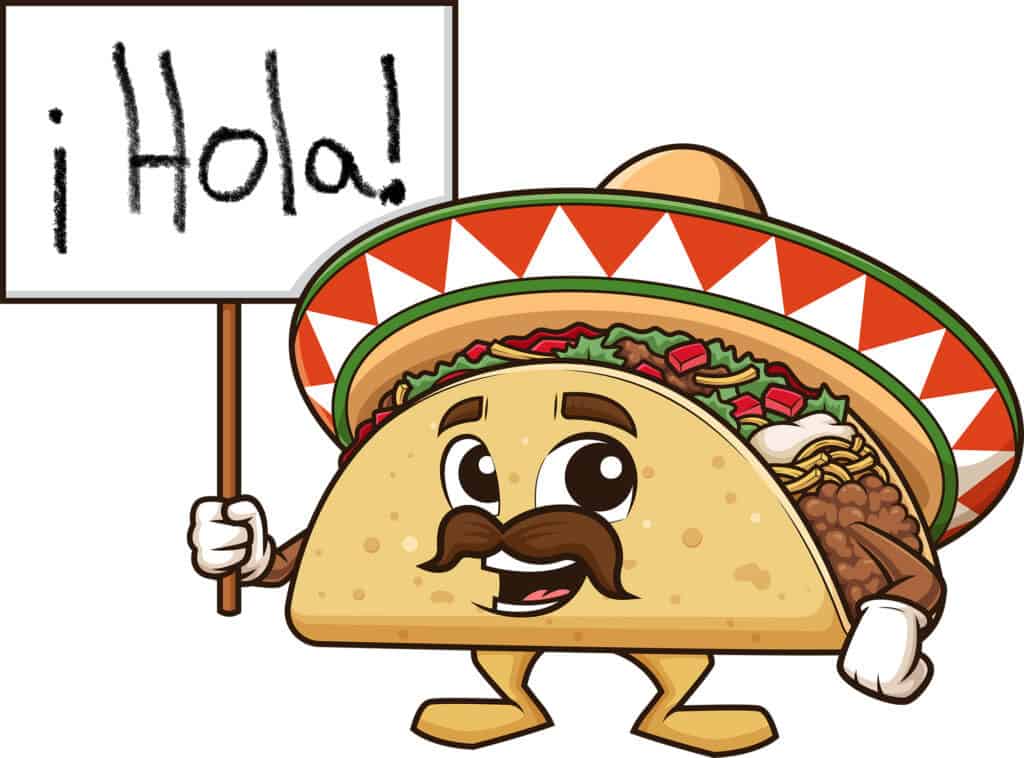
Do you know a person who speaks Spanish or have you ever wished you could habla español with someone? Considering the millions of people looking to learn Spanish as a second or other language, you probably answered yes to one or both questions. But is learning Spanish fun?
Yes, Spanish is a fun language to learn. Around the world, Spanish is known for its fun music, dance, food, and celebrations. Also, because there are over 480 million native Spanish speakers globally, learning Spanish provides fun opportunities that are professionally and personally worthwhile.
Though learning any second or other language, including Spanish, can be quite difficult especially for adults, there are things you can do to make it easier, and fun. I’ve spent almost 20 years teaching public schools in the United States and have learned some tricks to help make any kind of learning fun. Read on to discover what is fun and un-fun about learning Spanish!
Contents
So Many Reasons Spanish is Fun to Learn
Because of its high fun quotient, learning Spanish has potential to become your favorite hobby! There is so much to Spanish that you can get into….it’s a challenge to narrow it all down, but here goes my best effort!
Spanish Is Marketable
If you live in the United States, you won’t really be surprised by the professional opportunities available to those with second language Spanish skills. From the corporate field to service industries to education, Spanish/English fluency is in demand.
I’ve worked in three states at six different schools as a teacher and language specialist, and there has been no place where Spanish wasn’t useful. From my native Spanish speaking students to family communication, using Spanish was as necessary as having a sharpened pencil. In other words, useful! And I can’t imagine any other professional field where that would be different.
But was it fun? Absolutely! Conversation can always be fun-as long as the ability to communicate is there, you have the power to bring smiles and laughter! As well, if Spanish opens professional doors and improves your financial means, then that’s most certainly fun! Who has ever seen someone holding money and frowning?
Surplus of Spanish Speaking Partners

It won’t be long til you can Como Te Llamas (tee available at Amazon) with the best of them! In fact, with the abundance of Spanish speakers here in the U.S. , you’ll have ample opportunities for practicing your Spanish.
I’ve lived across the U.S., from west coast to east and down south, too. And I’ve found Spanish to be the most prevalent language other than English. To be honest, I probably encountered Spanish on a daily basis most weeks.
It would not be difficult at all to find strangers, co-workers, students, and so on, to practice my Spanish regularly. There is no need at all to pay for a tutoring partner or look for someone online to work on learning Spanish-if you or I don’t want to do that.
In fact, my husband, a martial arts master, uses Spanish in all of his children’s classes to infuse bilingualism along with karate, judo, and Taekwondo instruction.
Fun Spanish Culture

Food, Music, & Parties
I know from our days of living in Santa Clarita, just north of Los Angeles, that our native, Spanish-speaking neighbors always seemed to have a party going on! The day we moved in they had a bouncy house in the front yard and just about every weekend after, mariachi was booming from the back deck.
From tacos and paella to Mexican street corn, the food alone is cause for fiesta! Vibrant, flavorful, and usually edible with just your fingers is my definition of perfectly fun food! I mean, have you ever seen a person eating a taco mad? NOT ME! Tacos = F-U-N
Mariachi and Piñatas
Conquistadors and Flamenco
Tamales and Tapas
Spain has its running of the bulls and La Tomatina while Mexico celebrates the Day of the Dead and Constitution Day; Bolivia and Chile have their carnivals and Colombia has its annual flower fair! Here in the states we also celebrate Cinco de Mayo with entusiasmo, nachos, and Mexican beer.
Immersing yourself in Spanish-influenced foods from all over the Spanish-speaking parts of the world (Hey, no one said you have to limit your plate to Spain and Mexico!) and frequently participating in Spanish-culture celebrations will be a super-fun addition to your Spanish language learning.
Telenovelas
I’ve written extensively about learning Spanish with telenovelas here, so feel free to read that too. But to get the gist of the article is to recognize how amazing telenovelas are to making learning Spanish fun!
From the dramatic facial expressions to the flamboyant hairstyles and stiletto heels, telenovelas are designed to represent the opposite of boredom! I don’t think it’s possible for anyone to watch telenovelas and not smile or laugh out loud at some point, do you? You can’t help but get engrossed in the story line, too- making it essential fun for your Spanish learning!
Visiting Spanish Speaking Destinations
Spanish is the listed official language of 21 states/territories. That’s a lot of travel options! From Barcelona and Buenos Aires to Cartagena or Santo Domingo, there is a plethora of Spanish-speaking cities you can visit!
It’s always fun to go on a vacation, but when you can speak like the locals, you open up even more opportunities and options to expand your fun horizon!
Each of these Spanish-speaking towns and countries all have something unique to share with tourists, too- just more Spanish-culture actividades divertidas for you!
English-Spanish Cognates!
Cognates are words that are similar in multiple languages in meaning, pronunciation, and spelling. Because English takes so much of its vocabulary from Spanish, there are many cognates you already know! This makes it fun to learn Spanish because it’s like you got a head start!
For example, here’s a short list of English-Spanish cognates.
| English | Spanish |
| actor | actor |
| auto | auto |
| cancer | cancer |
| central | central |
| criminal | criminal |
| error | error |
| hospital | hospital |
| motel | motel |
| radio | radio |
Knowing these cognates will give you a bump ahead on your fun way to learning Spanish, but beware! There are some imposter cognates, too! These are words that sound/spell similarly but do NOT have the same or similar meaning.
For example one of the most infamous Spanish-English fake or imposter cognates is ‘embarazada’ which doesn’t mean ‘embarrassed’ in Spanish. Instead, it means pregnant!
Spanglish Spanish is Fun
Spanglish is a combination or smooshing together of English and Spanish. This is what a lot of my students would do.
Even though they learned English formally at school, many of them heard only Spanish at home, but weren’t actually ‘taught’ Spanish explicitly or directly growing up.
This meant they’d hear their parents talking to them in Spanish and then they’d respond in a mixture of English and Spanish vocabulary. My students were stronger in English but their parents only spoke Spanish, so they ultimately made a hybrid. This scenario has been replicated in many Spanish-American homes across the U.S.
Speaking Spanglish can be fun because it’s like its own little made up language; and every Spanish-American household’s Spanglish is unique!
Reasons Spanish is Un-Fun to Learn

Now just because there are so many reasons learning Spanish is fun, doesn’t mean there aren’t some things to make it ‘un-fun.’ Keep reading so that you are aware of the biggest causes to de-fun Spanish!
Choosing Mexico or Spain “Spanish”
When you choose to study Spanish, you do have to come to terms with either Spain/Spanish or Mexican/Spanish. Not many people are aware that there is a difference, but it is true.
There are some pronunciation differences, as well as differences in tenses, verbs, and vocabulary between Spain’s Spanish and what is called the Mexican-style (or Latin / Latino) of Spanish. You’ll be understood (and can understand others) in either place with either version, but it’s best to focus on one while learning.
I suggest you consider your reasoning for learning Spanish in order to decide. Are you more likely to visit Madrid or Cancun? Will you be speaking Spanish in Los Angeles or for your job as a hotel interpreter? In other words, tailor these questions to your situation and then, decide.
There’s no wrong decision here, but it’s necessary to know that this added complication can make your initial Spanish learning experience un-fun.
Spanish Grammar Rules are Muy Un-Fun
Oh, man, if you ask any student what’s the worst thing about learning languages, grammar rules has to be at the top of the list for 99.9% of people! Spanish is no different.
Like French, Spanish nouns have gender (masculine or feminine) so there are those rules to remember and learn.
There are multiple ways of saying ‘you’ in Spanish, too, so that can get tricky. Likewise, inflections are used a lot to convey meaning rather than using subject pronouns.
Last, Spanish vocabulary is abundant and doesn’t always translate word for word in English, so this makes it tricky- and not in a fun way!
Spanish Accents Can Be Difficult
Another thing that can make learning Spanish not-so-fun is the varying accents. From all the different places people speak Spanish, it shouldn’t come as a surprise that there are varying accents. However, it’s difficult to get used to!
How does this become important as you are learning Spanish? Listening and understanding what you hear is a major portion of immersing yourself in the language and culture. Sometimes the accent coupled with the speed at which the Spanish is spoken can make it challenging to understand even if you would otherwise know what was said.
In addition to accents, many people learning Spanish have difficulty keeping up with the speed of native Spanish speakers. This makes it challenging when practicing Spanish speaking, again….not fun!
Spanglish Spanish is also Un-Fun
Now I know I said that Spanglish makes learning Spanish fun, and that’s true. But in all fairness, it also complicates it some.
Because you aren’t fully using Spanish when using Spanglish, you are stalling your Spanish language progress.
If you mix English and Spanish, that might make things easier in the short-term, but it doesn’t help your overall Spanish fluency.
If it’s necessary for your immediate communication purposes, use Spanglish. But remember that if overall fluency is your goal, then you will want to limit your reliance on Spanglish.
This is why Spanglish can be un-fun!
How to Make Spanish Fun For You to Learn

One of the first things I learned as a teacher for lesson planning is how to incorporate differentiation for multiple learning styles and meeting the various learning needs of diverse students. Well, this goes for your language learning, also!
You’re sort of your own teacher. YOU decide your learning plan- tools, methods, materials (even if you aren’t designing the materials….you’re still selecting WHAT to use) and so on. But better than most teachers have it, you only have one student to tailor your plan to and that’s you, mi amigo!
So dig in and figure out what makes learning ANYTHING fun for you!
The Right Learning Tools Make Spanish Fun for You
Because of the ease of learning Spanish and the prevalence of need, Spanish language learning tools saturate the market! It seems nearly every single learning tool has a Spanish-language option (this isn’t true for all languages).
You can use apps on your smartphone or tablet; or enroll in your local college or university for courses. More than likely, your neighborhood library even offers Spanish language classes!
There are so many options today for making Spanish accessible and learning fun.
Because of the saturation, it can get overwhelming but it doesn’t have to be. Focus on your learning style. Are you a visual learner or do you prefer to listen to learn? Do you want to learn more independently at odd times of the day or would you excel in a group class?
Once you determine your learning style, select your tools. From internet options to workbooks to 1:1 tutoring, pick what works for your budget and lifestyle. After this, make a plan and stick to it!
Motivation is the Fun Factor to Learn Spanish
It’s so important that you figure out why you want to learn Spanish before ever starting it. Are you motivated to get a new, better job? Or is it something more personal like meeting new people or moving to a Spanish-speaking country?
The Modern Language Journal reported on a study connecting language learning and motivation; findings linked motivation as absolutely key to second (or other) language learning success. To read more about motivation and language acquisition, I’ve written in detail about it here.
After determining your motivation for learning Spanish, you also have to figure out what will keep you motivated in the short-term, during your journey of language learning. This is needed in order for you to not give up.
“It’s good to have an end to journey towards; but it is the journey that matters, in the end.” -Ernest Hemmingway
Famous author, E. Hemmingway, is credited with the quote above about keeping the journey in perspective. Sometimes, we miss the steps along the way and don’t realize their importance, as we focus myopically on our end goal (in this case, Spanish fluency).
However, the path is just as important, if not more so, than the ‘end’…because you will always be working on your Spanish fluency. It’s not really a finish line, is it?
Keeping this in mind is the meaning of Hemmingway’s inspirational quote.
Once you’ve outlined your motivational reasons, you’re ready to begin. Being consistent while focusing on your short and long-term motivations is what will keep you on your path to learning Spanish. And remember it’s your choice- if you aren’t motivated, you have the power to change that!
You need to immerse yourself in Spanish language activities that you enjoy. And enjoy means fun!
The Final Talking Point: Is Spanish Fun to Learn?
Let’s review our starting question: ‘Is Spanish Fun to Learn?’
Well, of course it is! As long as you immerse yourself in the parts of Spanish that are motivating to you, consistently, you will have mucho fun learning Spanish.
There are parts, as explained above, that aren’t considered Spanish-fun like grammar, pronunciations, and accent differentiations. But don’t let that discourage you. As long as you keep these issues in proper perspective, and focus on your why, then you have nothing to worry about.
With the abundance of fun available in learning Spanish, from enjoying mariachi to salsa dancing to fiestas, as well as the numerous tools to keep it fresh and varied, you will be well on your way to “muchos buenos dias!”
Additional Sources:
